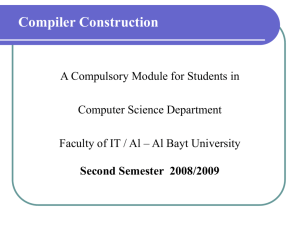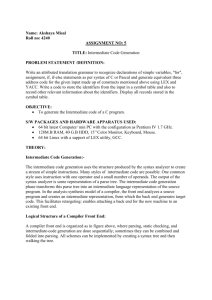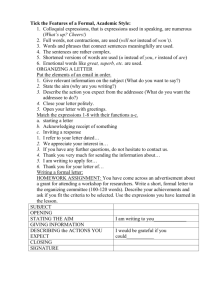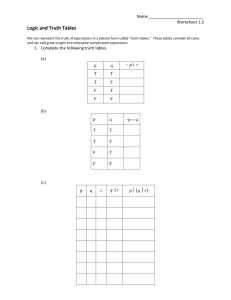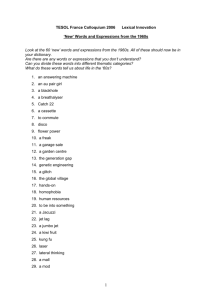Compiler chaptr
advertisement
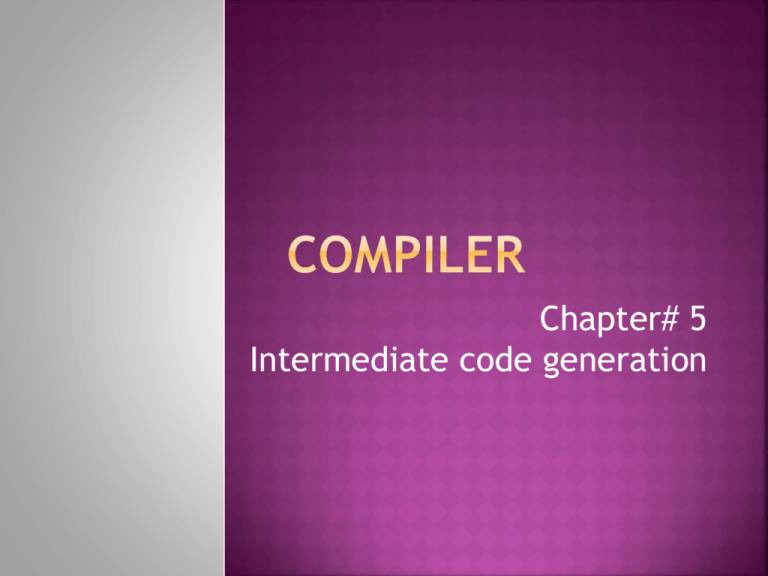
Chapter# 5
Intermediate code generation
In the analysis-synthesis model of a compiler, the front
end analyzes a source program and creates an
intermediate representation, from which the back-end
generates target code.
Intermediate codes are machine independent codes, but
they are close to machine instructions.
The given program in a source language is converted to
an equivalent program in an intermediate language by
the intermediate code generator.
Intermediate language can be many different
languages, and the designer of the compiler decides
this intermediate language.
o
o
o
Syntax trees can be used as an intermediate language.
Postfix notation can be used as an intermediate language.
Three-address code (Quadruples) can be used as an
intermediate language
We will use quadruples to discuss intermediate code
generation
Quadruples are close to machine instructions, but they
are not actual machine instructions.
some programming languages have well defined intermediate
languages, for example: Java: Java virtual machine (JVM)
In fact, there are byte-code to execute instructions in these
intermediate languages.
Nodes
in a syntax tree represent constructs in the
source program.
The children of a node represent the meaningful
components of a construct.
A directed acyclic graph (DAG) for an expression
identifies the common sub-expressions (sub-expression
that occur more than once) of the expression.
DAG’s can be constructed by using the same
techniques that construct syntax tree.
Cyclic Graphs for Expressions
a+ a*(b–c)+(b–c)*d
+
+
*
*
d
a
b
c
Like the syntax tree for an expression, a DAG has leaves
corresponding to atomic operands and interior codes
corresponding to operators.
The difference is that a node N in a DAG has more than
one parent if N represents a common sub-expression.
In a syntax tree, the tree for the common sub-expression
would be replicated as many times as the sub-expression
appears in the original expression.
Thus DAG not only represents expressions more
succinctly, it gives the compiler important clues
regarding the generation of efficient code to evaluate the
expressions.
The
leaf for a has two parents, because a appears
twice in the expression.
The two components of the common subexpression b-c are represented by one node, the
node labeled -.
That node has two parents, representing its two uses in
the sub-expression a*(b-c) and (b-c)*d.
In
three-address code, there is at most one operator
on the right side of an instruction.
Thus a source language expression like x+y*z
might be translated into the sequence of threeaddress instructions
t1 = y * z
t2 = x + t1
Where t1 and t2 are compiler-generated temporary
names.
Three-address code is built from two concepts: address
and instructions.
Three-address code can be implemented using records
with fields for the addresses, records are called
quadruples and triples.
An address can be one of the following:
A name: For convenience, we allow source-program names
to appear as addresses in three-address code.
A constant: In practice, a compiler must deal with many
different types of constants.
A compiler-generated temporary: It is useful, especially in
optimizing compilers, to create a distinct name each time a
temporary is needed.
We
now consider the common three-address
instructions.
Assignment instructions of the form x = y op z
where op is a binary arithmetic or logical operation,
and x,y and z are addresses.
Assignment of the form x = op y, where op is a unary
operation.
Copy instruction of the form x=y, where x is assigned
the value of y.
The description of three-address instruction specifies the
components of each type of instruction.
In a compiler, these instructions can be implemented as
objects or as records with fields for the operator and the
operands.
Three such representations are called “quadruples”, “triples”
and “indirect triples.”
A quadruple has four fields, which we call op, arg1, arg2, and
result.
The op field contains an internal code for the operator.
For instance the three-address instruction x=y+z is represented
by placing + in op, y in arg1, z in arg2, and x in result.
1.
2.
The following are some exceptions to this rule:
Instructions with unary operators like x= minus y or
z=y do not use arg2.
Conditional and unconditional jumps put the target
label in result.
The
special operator minus is used to distinguish
the unary operator, as in –c, from the binary minus
operator, as in b-c.
Note that the unary-minus “three-address”
statement has only two addresses, as does the copy
statement a=t5.
The quadruples in figure(b) implement the threeaddress code in (a) as follows:
op
t1 = minus c
t2 = b * t1
t3 = minus c
t4 = b * t3
t5 = t2 + t4
a = t5
(a) Three-address code
arg1
0 minus
c
1
b
*
arg2
result
t1
t1
t2
2 minus
c
t3
3
*
b
t3
t4
4
+
t2
t4
t5
5
=
t5
(b) Quadruples
a
A triple has only three fields, which we call op, arg1, arg2.
Note that the result field in previous figure is used
primarily for temporary names.
Using triples we refer the result of an operation x op y by
its position, rather than by an explicit temporary name.
Thus, instead of the temporary t1 in Figure((b)previous
slide), a triple representation would refer to position (0).
Parenthesized numbers represent pointers into the triple
structure itself.
Positions or pointers to positions were called value
numbers.
=
op
a
+
*
b
*
minus
b
c
Syntax tree
minus
c
arg1
0 minus
c
1
b
*
arg2
(0)
2 minus
c
3
*
b
(2)
4
+
(1)
(3)
5
=
a
(4)
(b) Triples
The applications of types can be grouped under checking
and translation:
Type checking uses logical rules to reason about the behavior
of a program at runtime. Specially, it ensures that the types of
operands match the type expected by an operator. For
example, the && operator in Java expects its two operands to
be Boolean, the result is also type Boolean.
Translation: From the type of a name, a compiler can
determine the storage that will be needed for that name at run
time. Type information is also needed to calculate the address
denoted by an array reference.
We
begin in this section with the translation of
expressions into three-address code.
An expression with more than one operator, like
a+b*c, will translate into instructions with at most
one operator per instruction.
An array reference A[i][j] will expend into a
sequence of three-address instructions that
calculate an address for the reference.
Array
elements can be accessed quickly if they are
stored in a block of consecutive locations.
In C and Java, array elements are numbered
0,1,2,……,n-1 for an array with n elements.
If the width of each array element is w, then the ith
element of array ‘A’ begins in location
base + i x w
Base is the relative address of A[0].
To
do type checking a compiler needs to assign a
type expression to each component of the source
program.
The compiler must then determine that these type
expression conform to a collection of logical rules
that is called the type system for the source
program.
Type checking has the potential for catching errors
in programs.
Consider expressions like x + i, where x is of type float and
i is of type integer.
Since the representation of integers and floating-point
numbers is different within a computer and different
machine instructions are used for operations on integers
and floats.
The compiler may need to convert one of the operands of +
to ensure that both operands are of the same type when
addition occurs.
Suppose that integers are converted to floats when
necessary, using a unary operator (float).
For example, the integer 2 is converted to a float in the
code for the expression 2 * 2.14
t1 = (float) 2
t2 = t1 * 3.14
The
translation of statements such as if-elsestatements and while-statements is tied to the
translation of Boolean expressions.
In programming languages, Boolean expressions
are often used to
1. Alter the flow of control: Boolean expressions
are used as conditional expressions in statements
that alter the flow of control.
2. Compute logical values. A Boolean expression
can represent true or false as values.
Boolean
expressions are composed of the Boolean
operators (which we denote &&, ||, and !, using the
C convention for the operators AND, OR, NOT,
respectively) applied to elements that are Boolean
variables or relational expressions.
Relational expressions are of the form E1 rel E2,
where E1 and E2 are arithmetic expressions.
B B || B | B && B | !B | (B) | E rel E | true | false
We use the attribute rel.op to indicate which of the
six comparison operators <, <=, ==, !=, >, >= is
represented by rel.
Given
the expression B1 || B2, if we determine that
B1 is true, then we can conclude that the entire
expressions is true without having to evaluate B2.
Similarly,
given B1 && B2, if B1 is false, then the
entire expression is false.
The “switch” or “case” statement is available in a variety of
languages.
Our switch statement syntax is given bellow:
switch( E )
{
case V1 : S1
case V2 : S2
………..
case Vn-1 : Sn-1
default : Sn
}
There is a selector expression E, switch is to be evaluated,
followed by n constant values V1,V2,…Vn that the
expression might take, perhaps including a default “value”,
which always matches the expression if no other value does.
The
1.
2.
3.
intended translation of a switch is code to:
Evaluate the expression E.
Find the value Vj in the list of cases that is the
same as the expression.
Execute the statement Sj associated with the value
found.


